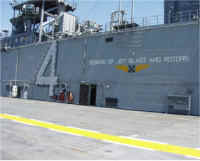Flight Deck |
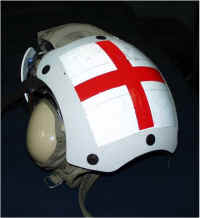
|
The flight deck covers 2.2 acres and is
designed to accommodate any helicopter in the U.S. inventory and AV8B
Harrier aircraft.
Up to 24 helicopters and 6 Harriers can be stored on the flight deck.and flight deck personnel can control up to nine helicopters at one time. It is the most dangerous part of the entire ship. Only specially trained and qualified personnel can be on the flight deck. Unless you hold those qualifications, you will always be escorted by someone who does, whenever it is necessary for you to be on the flight deck. All flight deck personnel are identified by the color jacket and markings of their helmet. This helmet with the red cross is for medical personnel. Entry to the medical spaces on the flight deck is through the double doors. |
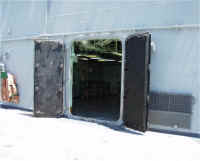 |
During flight operations, these doors are
normally closed.
That's good, because the flight deck is very noisy. To receive casualties, the double doors are opened, allowing rapid entry of ambulatory and litter patients into the medical stabilization area. |
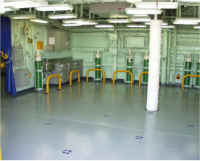 |
The medical stabilization area is a large
space, surrounded by cabinets with medical supplies, and oxygen
tanks.
Tie-downs are built into the floor to allow patient litters or equipment to be secured in heavy seas. Most of the time, that isn't necessary, and litters are simply placed on litter stands. |
 |
IV's, bandages, and other medical equipment is
readily available in the cabinets along the walls.
An ice machine allows for rapid icing of traumatized tissues. |
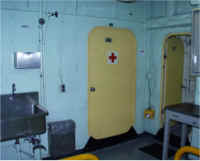 |
In the corner of the stabilizing area is the Battle
Dressing Station (BDS).
This is a small surgical area capable of serving several roles. |
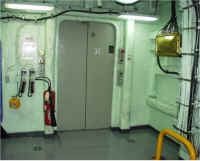 |
The elevator takes up to 6 litter patients directly down to the Triage Area of the Medical Department. |
 |
The ship's morgue is located just off the stabilization spaces. |
Bureau of Medicine and
Surgery |
Operational
Medicine |
United States Special Operations Command 7701 Tampa Point Blvd. MacDill AFB, Florida 33621-5323 |
Home · Military Medicine · Sick Call · Basic Exams · Medical Procedures · Lab and X-ray · The Pharmacy · The Library · Equipment · Patient Transport · Medical Force Protection · Operational Safety · Operational Settings · Special Operations · Humanitarian Missions · Instructions/Orders · Other Agencies · Video Gallery · Phone Consultation · Forms · Web Links · Acknowledgements · Help · Feedback ·
This web version is brought to you by The Brookside Associates Medical Education Division · Other Brookside Products · Contact Us
